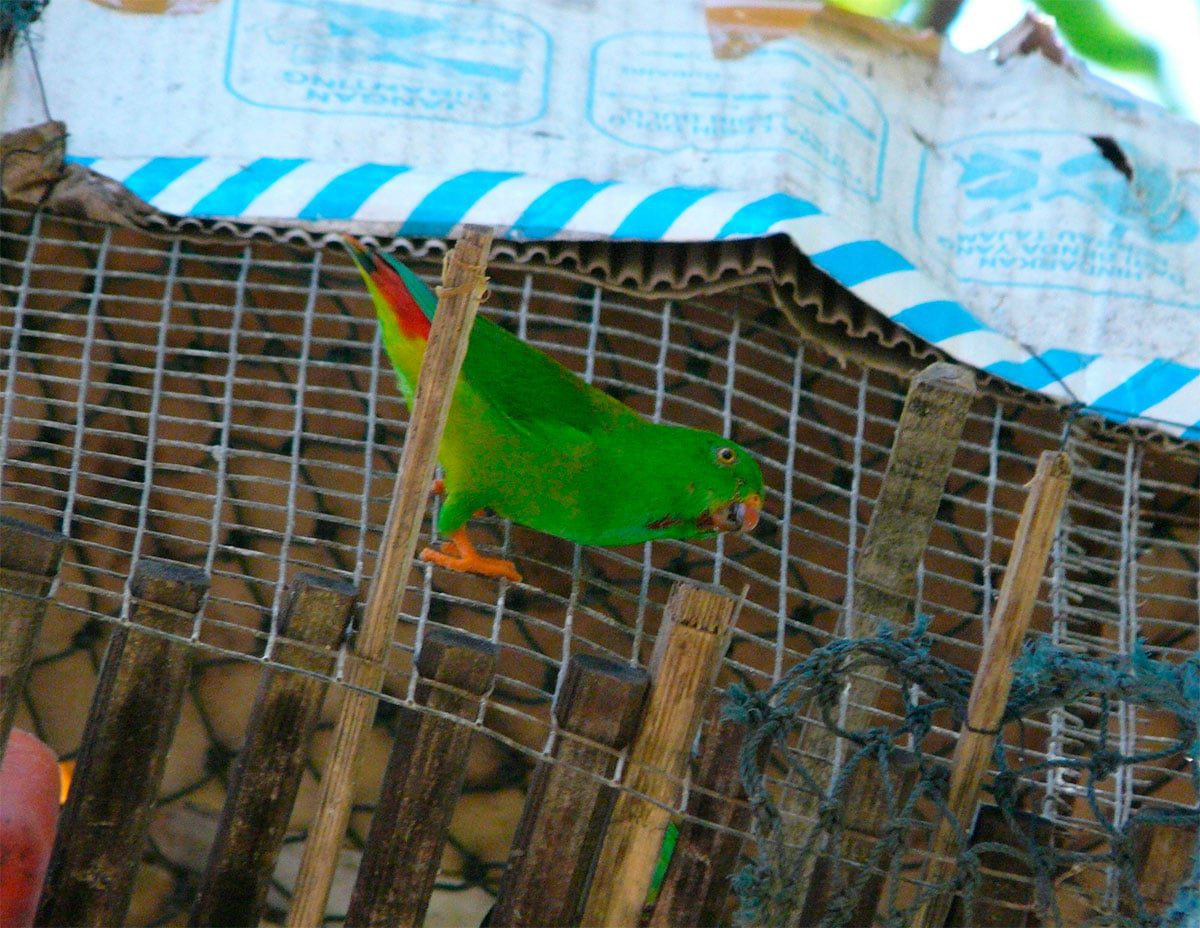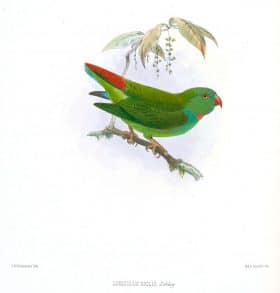Content
|
|---|
Description
10 to 11 cm.. length.
The head of the Pygmy hanging parrot (Loriculus exilis) is green, brighter around the base of the bill and bathed in bluish green at the chin, the throat, the cheeks and the part front of it crown.
The underparts is green, with the rump and uppertail-coverts dark red (very extended below the tail); the sides and the base of the rump are greenish-yellow. Wings green. Under, the wings Turquoise with coverts green. Throat of color red bordered of blue pale and extending is about part superior of the chest; rest of the underparts green, slightly more clear that the upperparts. The tail, at the top, Green with yellowish tips; undertail, the tail is of a pale color green blue.
The bill coral red; irises yellow; legs oranges.
The females lack of the bib red (or have very small bib). Also have a reduced blue diffusion in the chest and irises brown.
The young birds they have a bib Red small, a bill yellowish brown, and a pale brown iris.
- Sound of the Pygmy hanging parrot.
Habitat:
Usually little-known. It is distributed by forests, coastal mangroves, around the villages and in the open field, from the lowlands to the wooded hills to some 1.000 m, altitudes and in similar habitats to the of the Great hanging parrot.
The birds are found in groups of up to five copies, feeding in the canopy of figs or the trees in flower nectar; their power moves have been compared with the movements of crawling in the Pygmy Parrot Micropsitta. Larger flocks have been found in the mangroves during may, Although the species can reproduce twice a year, in February and August; it is not known if these represent post-breeding concentrations or nomadic groups.
Reproduction:
A hole in a dead palm tree is the only known record of a zone of nesting.
Food:
Feeds of figs or nectar.
Distribution:
Size of the area of distribution (reproduction / resident): 103.000 km2
Endemic to Sulawesi, where is located from the North, on Minahassa Peninsula, to the South.
Conservation:
• Current IUCN Red List category: Near threatened
• Population trend: Decreasing
The size of the world population It has not been quantified, Although it is estimated at more than 10.000 specimens. The species is described as uncommon and rare.
There are no data on trends in the population, but the species is suspected to be decreasing at a moderately fast pace, due to degradation of the habitat.
"Pygmy hanging parrot" in captivity:
Very rare in captivity.
Alternative names:
– Red-billed Hanging-Parrot, Celebes Lilliput Hanging-Parrot, Green Hanging Parrot, Green Hanging-Parrot, Lilliput Hanging-Parrot, Pygmy Hanging Parrot, Pygmy Hanging-Parrot, Red billed Hanging Parrot, Red-billed Hanging Parrot, Talabula Hanging-Parrot (ingles).
– Coryllis vert (French).
– Däumlingspapageichen, Däumlings-Papageichen (German).
– Lorículo Exiguo (Portuguese).
– Lorículo Exiguo (español).
scientific classification:
– Order: Psittaciformes
– Family: Psittaculidae
– Genus: Loriculus
– Scientific name: Loriculus exilis
– Citation: Schlegel, 1866
– Protonimo: Loriculus exilis
Videos "Pygmy hanging parrot"
Videos "Pygmy hanging parrot"
————————————————————————————————
“Pygmy hanging parrot” (Loriculus exilis)
Sources:
– Avibase
– Parrots of the World – Forshaw Joseph M
– Parrots A Guide to the Parrots of the World – Tony Juniper & Mike Parr
– Birdlife
– Photos:
(1) – By Peter Waanders – Caged female has attracted wild male. lynx
(2) – Loriculus exilis by John Gerrard Keulemans [Public domain], via Wikimedia Commons
– Sounds: Mike Nelson (Xeno-canto)



